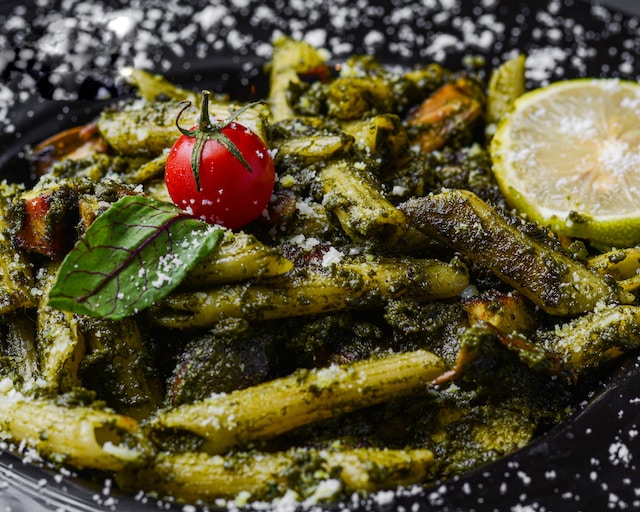A good sauce doesn’t have to be loaded with milk, cheese, and butter. The wonderful thing about plants and plant-based ingredients is how flexible they can be. Whether you’re vegan, dairy-sensitive, or simply trying to branch out a little, exploring alternative sauces might lead you to your next favorite meal. While you can buy vegan sauces, making your own doesn’t have to be complicated. Use these guidelines to whip up a delicious sauce for everything from pasta to cauliflower steak (or cow steak).
Crafting your own plant-based sauce is a matter of balancing a few different components; it’s not all that different from building a “regular,” dairy-inclusive sauce. While you can certainly blend up a watery vegetable and add season it with salt and spices (tomato sauce is a certified hero), this genre of sauce can separate into water and plant matter after a few minutes. For a more emulsified sauce, you’ll need a liquid, a binder, and (sometimes) a main flavor component.
I say “sometimes” because either the binder or liquid can also double as the main flavor. To complete your saucy assignment, you’ll need a blender you can trust. Any budget standard blender, food processor, or immersion blender will do the trick. If you see yourself permanently getting involved with liquifying things, go for a higher end blender that’ll take down even the most fibrous of veggies.
Choose your liquid
Many sauces use milk, like the classic béchamel, but you have a lot of other options. Swap it out for a non-dairy milk, oil, veggie broth or stock, pasta water, or aquafaba. The liquid component will help you reach the ideal consistency you’re looking for. Fibrous plants can absorb water after blending, so keep a little extra around in case you need to thin out the sauce afterward.
Choose your binder
The binder is the fun part. Odds are that this is your main vegetable, or you’ll have a main vegetable with a binder-helper. Look for an ingredient that has a good deal of fiber, fat, or a thickening agent in it. A vegan mayo comes with thickening agents, like xanthan gum, a ripe avocado has a good amount of fat, leeks contain lots of luscious pectin, and broccoli contains a useful dose of fiber. Beans, nuts, and seeds make for excellent binders because they come with both emulsifying fibers and fats of their own. The extra step with those three is soaking. No one wants a gritty sauce, so make sure you soak your beans, nuts, and seeds for a few hours, if not overnight. To get around soaking, use canned beans, which are already plenty soft, or nut and seed butters.
Choose your main flavor
The main flavor of your sauce can be simple with a single vegetable or spice, or you can give it the works with a mix of flavors. For a distinctly vegetal sauce, add a couple handfuls of spinach, or a soft-cooked vegetable like broccoli, caramelized onions, roasted red peppers, or carrots. Try a couple tablespoons of nutritional yeast to get a cheesy flavor. To make a “ranch” sauce, opt for equal proportions minced garlic, chives, dill, onion powder, and sprinkle of mustard powder (and a pinch of MSG). If you want some smoke, you can make a last minute change at the blender stage and drop in a single marinated chipotle pepper.
Once you have your components, you’re can do a raw sauce or a cooked one. I recommend cooking any hard or fibrous ingredients that might need a little help softening up, like broccoli, kale, celery, or potatoes. This will also ensure a smoother sauce if your blending device is a little dull. Add the ingredients to a pot and simmer until the primary vegetables are softened or wilted, approximately 5–15 minutes. Reserve about a quarter of the liquid to adjust your consistency later. Add the mixture to a blender, or use an immersion blender, and purée. Adjust the consistency if needed with the reserved liquid.
Soft ingredients, like soaked cashews or beans, and tender fruits and vegetables, like baby spinach or zucchini, are excellent for a raw sauce. Add the ingredients to a regular blender, or a tall vessel if you’re using a stick blender. Like the cooked version, reserve a small amount of the liquid for later. Add the bulk of the liquid component first so the blades have access to the lubrication, spices or dry ingredients next, and the other ingredients on top. Purée, and use the reserved liquid to adjust the sauce if needed.
One of my favorite veggie sauces is soft-cooked broccoli with onions, garlic, and broth. The addition of an emulsifying fat (besides the teaspoon of olive oil for cooking the onion) isn’t needed because the fibrous veggies aerate and emulsify perfectly well on their own after blending. Try it out, then play around with other vegetables and bases.
You can always start simple. If it’s your first foray with plant-forward sauces, you can use a recipe you like already, and see if there are simple swaps you can make, like a béchamel with almond milk instead of cow milk, and oil or margarine instead of butter. The veg-chamel will have its own exciting nuances, and you can continue your plant explorations from there.
Photo by amin ramezani
Silky Broccoli Sauce
Ingredients:
- 1 teaspoon olive oil
- ½ medium onion, roughly chopped
- 3 cloves garlic, crushed or chopped
- 2 cups broccoli florets
- ½ teaspoon salt
- ⅛ teaspoon baking soda
- 1-2 cups of broth
In a medium pot over medium-low heat, add the olive oil, garlic, and onion. Sauté until softened and the onion is browning slightly. Add the broccoli, salt, baking soda and one cup of broth. Cover with a lid and reduce the heat to a simmer for 10 minutes. Stir and break apart the broccoli to check out how it’s softening. Cover, and cook for another 5 minutes. The broccoli should be easy to break and buttery soft. Turn off the heat and blend the mixture. If it’s too thick add more broth until you reach your desired consistency. Great tossed with pasta or slathered on potatoes.
This article was written by Allie Chanthorn Reinmann from Lifehacker and was legally licensed through the Industry Dive Content Marketplace. Please direct all licensing questions to legal@industrydive.com.









